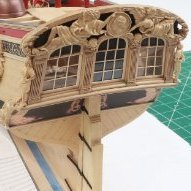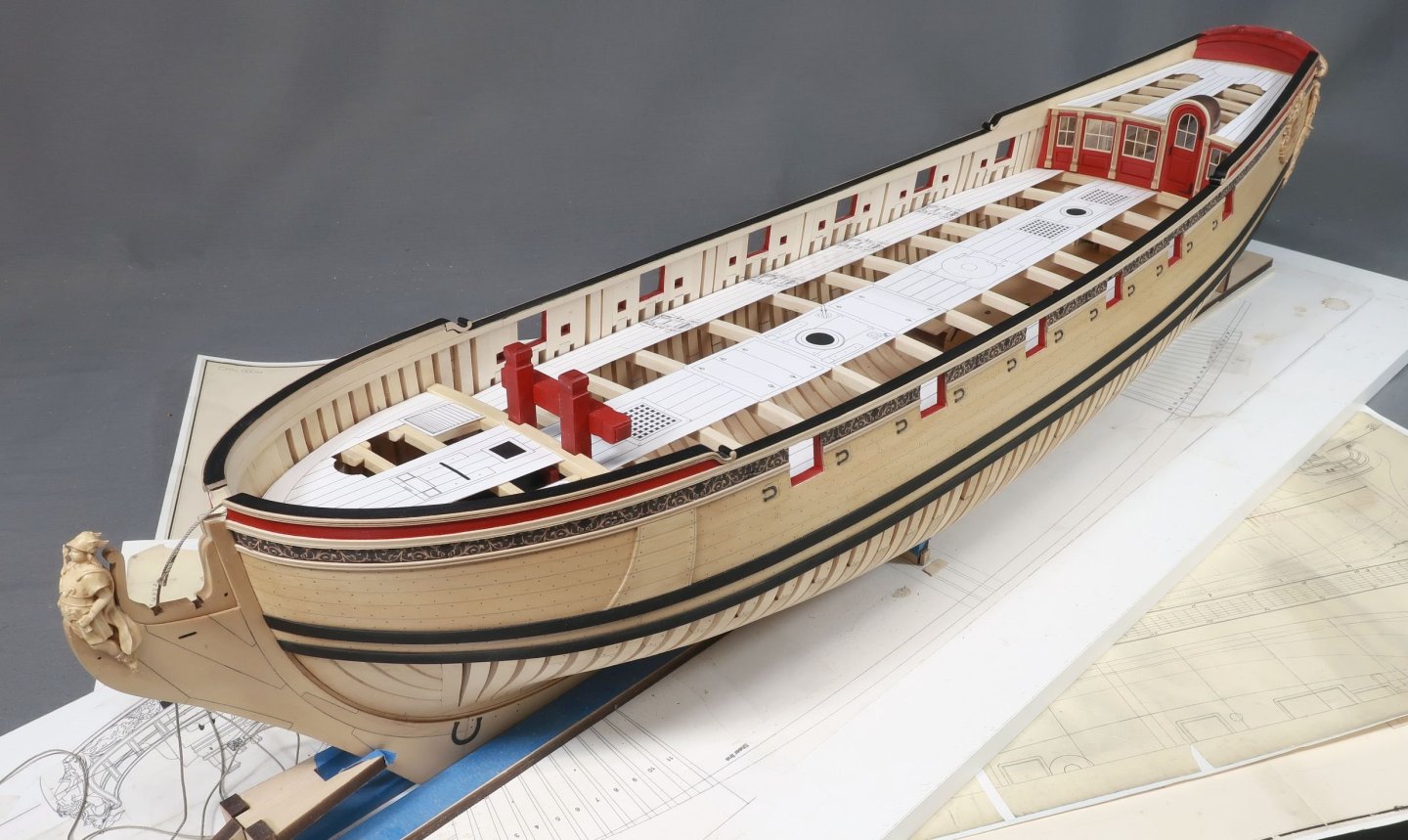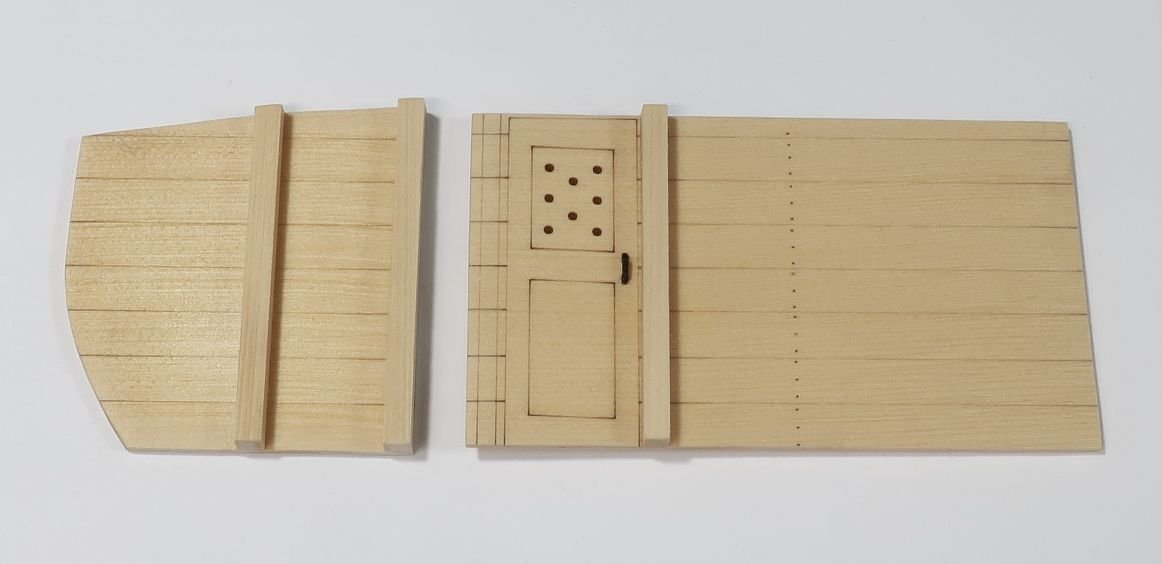-
Posts
9,690 -
Joined
-
Last visited
Content Type
Profiles
Forums
Gallery
Events
Everything posted by Chuck
-
Thank you guys... I took a crack at the sailroom. First I had to make the posts for the partitions. There are thin laser cut strips that need to be glued to the sides of some 3/32" x 3/32" strips. It might be hard to see but the laser cut strips are wider than needed. You have to line up the open side with the edge of the 3/32" strip. Let the other side hang over. The upright on the left shows this. Once the glue dries, you can sand that overhang down flush with the 3/32" strip. This will leave rows of slanted slots for the louvers. They should be open on both sides after sanding off the overhang. There is also a long slot down the front edge that is created. This is for the planked bottom of each partition. It is all shown on the plans. The corner post gets two of these laser cut strips with the notches. Just be careful when you glue them on so they are facing the right direction and the louvers will be able to slip into the slots easily. Next I added the laser cut planked bottoms. This essentially makes a nice two-sided partition. The planking will fit into those long notches on the posts. It is probably easier to see them in the photo below. Keep a nice 90 degree corner with both sides. Then its time to fit all of the louvers...for ventilation. They are 3/32" x 1/64" strips. Just cut them to length and start adding them. Eight on each panel. To finish off the sailroom..I made the door. This is in two layers like all of the other bulkheads. I made the door up and added the hinges and door handles. Then I glued it to the louvered section of the sailroom. Like this. Now I could easily position the entire sailroom...hopefully. It should line up and fit onto the 3/32" post already on the boatswains cabin. And yes...we can finally glue the riding bitts into position permanently. This pretty much finishes the cabins at the bow. I was originally going to add a sail rack in the sailroom. But after a lot of thought I realized it would never be seen. The sailroom is pretty much covered up entirely by the deck planking and the deck beams. In this photo I have fitted the deck beams as a test. There will be several more between these larger deck beams too. There are thin 3/32" deck beams...sometimes 3 or 4 between each of these larger deck beams. They will obscure so much of the lower deck items. But hopefully you will get a glimpse of some of this stuff as it is quite a bit of work to build it all. The contemporary model with its many deck beams..
-
And nobody will ever see that detail once the deck beams and deck planking are completed. Too funny Greg. It actually takes a lot longer to design and draft these partitions than it does to build them. Once they are actually laser cut, it takes no time at all to clean them up and install them. If only I could find someone else to do that front end work for me. The sail room partitions wont be fun to design I can tell you that.
-
Starting chapter 7 The first thing I wanted to do, just to get it out of the way...was to get all the gundeck beams made. I cleaned the char off of all 11 beams now. Then they were cut to length using the plans as a guide. I also used the plans to establish where each deck beam is positioned. For now I will just set them aside and grab them as I need them. The last thing I wanted was to have to stop what I am doing just to clean char off a beam and cut it to length. Its a comfort knowing they are all done and ready. The photo below shows all the beams just resting on the deck clamp. This allowed me the opportunity to cut all the templates and see what the planking scheme would look like so I can adjust it now rather than later. I think its a good plan as is...and I wont make any adjustments, yet. With the beams all ready and at hand, I could start making the cabins on the lower platform at the bow. Each bulkhead will be made in two layers. Both are 1/32" thick and are laser etched with a bunch of reference lines. Now it would be easy enough to make these from scratch but this does make the building process quicker. Especially since very little of these will be seen. Below are the sections for the carpenters cabin on the starboard side. It shows both sides. I cleaned the char from the inside edges of the door panels and then glued up each layer. Before I add any details I made sure they fit on the model. I adjusted them to fit nicely in position and adjusted the heights etc. This is why it is good to have those deck beams handy. You need to have the first two beams in position to get the heights correct. Once I was sure they fit on the model OK (see the deck layout for details), I started added the hinges and stanchions. First I added the upright timbers which are either 1/8" x 1/8" strips cut to length or 3/32" x 3/32" strips. The plans show which. Then I added the door handles and hinges. Make sure to add the handles on both sides of the door. And be careful to put them on the correct side based on which way the doors open. The outside view of both bulkheads completed. The interior of the carpenters cabin detailed. Finally they were glued into position on the model. I placed the side with the doors first. Just use your planking of the lower platform to position it straight and against the stanchion on the fcastle bulkhead. Then I added the smaller section along the aft edge of the platform. This will probably need the outside edge to be sanded because I laser cut them longer than needed. So adjust the side that butts up against the frames. But remember, there isnt any planking on the inboard side of the frames so it is expected to show a gap. Just get it as even and consistent as you can. The carpenters cabin and boatswains cabin completed. Note how the top of the bulkheads against the deck clamp are flush with the top of the deck clamp. Next up will be the sail room. But that needs to be built a different way because of the louvered walls for ventilation. Chuck
-
Yes indeed. I am however probably going to stick with the how the cont. model was portrayed. Its easy enough to add a few more swivel stocks for folks who want to add them. Builders choice. Aesthetically, they just ruin the elegant run of the sheer to my eye. If I were to include them however I would certainly add a rope railing with stanchions along the poop as shown on that draft detail I posted of "Fly". I think it would make sense to my eye anyway. But I am going to stick with just the few swivels mounted at the bow. I have gone with the model for so many other things.....number and position of timberheads etc. Although I have also been swayed on some other things shown on the original draft as opposed to the model. Its a trade-off. Once you start looking you will spot so many differences....between all of these primary source references. I forget how many swivels you ended up with per side. Seven or eight? The draft for Cruiser does show a heck of a lot more swivels...as shown below (bottom). Just to show folks who will build the kit and want to go another way. Cont model with two swivel stocks per side. Speedwell draft with two swivel stocks per side. Cruiser class draft with 10 swivel stocks per side. Very different appearance with the open sheer rails as well.
-
This is optional of course as it might obscure the elegant curve of the sheer. But as I mentioned the bulwarks are not very high along the poop. Having said that, there would have been a rope railing and stanchions there. In fact, several drafts of similar sloops actually show them. You may add them if you really want to and it would be historically correct. This is from a draft of “Fly” from the same year. Note the stanchions. There are other features shown on this draft which are not shown for Speedwell that could be used as well. It all depends on how true to the contemporary model you want to be. For example. The ladder down to the lower platform. Speedwell does not show one but who knows. In addition..the swivel stocks. Which you will see Greg added but are not shown on the Speedwell contemporary draft.
-
Putting in his lunch order. But seriously….they are same figure and just used for scale. I actually move him around as I develop the drawings. Insane how tight the spaces were and low the ceilings were. I placed him near the tiller on the poop deck also…no railings port and starboard. Crazy stuff…lucky if the bulwarks are knee high… Just high enough to trip overboard.
-
I dont use a scientific method at the stem or the stern. For that I use either thin tape or string along all of the other tick marks and just extend them to the bow by “eye”. Its a bit of both art and math when lining off a hull. Adjust the tape or string by eye examining the hull a lot from various angles. When satisfied…mark the locations along the stem post and stern post with a pencil.
-
The fcastle deck beams were glued into position . The knees, carlings and ledges for the hatches were added as per the usual. The knees are laser cut and just need some sanding to get a tight fit against the frames. The ledges and hatch framing is completed with 1/8 x 1/8 strips. Cut them to length and follow the framing plan. To finish off the fcastle for now...the ladder was made for the companionway on the starboard side. You can just make that out in the photo. This is as far as I will take the fcastle which matches where I left off on the poop deck. So this completes chapter six believe it or not. Chapter seven begins with the few cabins and sail room on the forward lower platform. More to come on that soon I hope. But I have to start laser cutting some more chapter sets and making more rope. Having a real job stinks....what I wouldn give to hit the numbers tonight, LOL. Chuck
-
Its up to you. I found it easier to add them as I go. As long as you have a frame on either side you can add the shorter frames. I also added the port fillers as I went but that is something you can wait to do until you have three or 4 ports to make. This way you can use the template to make sure they are all at the same height and spaced accordingly. But its up to you.
About us
Modelshipworld - Advancing Ship Modeling through Research
SSL Secured
Your security is important for us so this Website is SSL-Secured
NRG Mailing Address
Nautical Research Guild
237 South Lincoln Street
Westmont IL, 60559-1917
Model Ship World ® and the MSW logo are Registered Trademarks, and belong to the Nautical Research Guild (United States Patent and Trademark Office: No. 6,929,264 & No. 6,929,274, registered Dec. 20, 2022)
Helpful Links
About the NRG
If you enjoy building ship models that are historically accurate as well as beautiful, then The Nautical Research Guild (NRG) is just right for you.
The Guild is a non-profit educational organization whose mission is to “Advance Ship Modeling Through Research”. We provide support to our members in their efforts to raise the quality of their model ships.
The Nautical Research Guild has published our world-renowned quarterly magazine, The Nautical Research Journal, since 1955. The pages of the Journal are full of articles by accomplished ship modelers who show you how they create those exquisite details on their models, and by maritime historians who show you the correct details to build. The Journal is available in both print and digital editions. Go to the NRG web site (www.thenrg.org) to download a complimentary digital copy of the Journal. The NRG also publishes plan sets, books and compilations of back issues of the Journal and the former Ships in Scale and Model Ship Builder magazines.






























